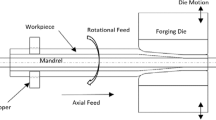Abstract
In this work, a comprehensive study of radial forging process is presented through 2-D axisymmetric and 3-D finite element simulations while considering internal tube profile. The tube used in this investigation has four internal helical grooves along its length. The material is modeled with the elastic-plastic behavior, and sliding-sticking friction model is utilized to model the die-workpiece and mandrel-workpiece contacts. The numerical results in the 2-D case are compared with available experimental data. Residual stresses in the forged product, stress concentration around the grooves, pressure distribution on the hammers and mandrel and maximum forging load are studied. The effects of process parameters such as workpiece and die geometries, percentage of deformation, and workpiece motions on residual stresses and applied pressures on the hammers and mandrel are investigated. The results provide a valuable insight into the parameters affecting radially forged products and provide a useful tool for better design of this process.
Similar content being viewed by others
References
Rauschnabel E, Schmidt V (1992) Modern application of radial forging and swaging in the automotive industry. J Mater Process Technol 35:371–383
Lahoti GD, Liuzzi L, Altan T (1977) Design of dies for radial forging of rods and tubes. J Mech Work Technol 1:99–109
Thompson EG, Hamzeh O, Jackman LA, Srivatsa SK (1992) A quasi-steady-state analysis for radial forging. J Mater Process Technol 34:1–8
Jang DY, Liou JH (1998) Study of stress development in axi-symmetric products produced by radial forging using a 3D nonlinear finite element method. J Mater Process Technol 74:74–82
Lahoti GD, Altan T (1976) Analysis of the radial forging process for manufacturing rods and tubes. J Eng Ind 98:265–271
Lahoti GD, Altan T, Dembowski PV (1976) Radial forging of tubes and rods with compound-angle dies. Fourth North America Metalworking Research Conference, Columbus, OH, May 1976, pp 87–93
Paukert R (1983) Investigation into metal flow in radial forging. Ann CIRP 32(1):211–214
Rodic T, Stok, Gologranc F, Owen DRJ (1987) Finite element modeling of a radial forging process. In: Lange K (ed) Adv Technol Plasticity 2:1065–1072
Domblesky JP, Jackman LA, Shivpuri R, Hendrick BB (1994) Prediction of grain size during multiple pass radial forging of alloy 718. In: Loria EA (ed) Superalloys 718, 625, 706 and various derivatives. TMS, Warrendale, PA, pp 263–272
Jackman A, Ramesh MS, Forbes-Jones R (1992) Development of a finite element model for radial forging of Superalloys, Proc Int. Symp. on the Metallurgy and Applications of superalloys, Pittsburgh, PA, TMS Sept 1992, pp 103–112
Domblesky JP, Shivpuri R, Mohamdein MK (1996) FEM simulation of multiple pass radial forging of pyromet, Proceeding of the Int. Symp. on the Metallurgy and Applications of superalloys, Pittsburg 26–29 June 1994
Domblesky JP, Shivpuri R, Painter B (1995) Application of the finite element method to the radial forging of large diameter tubes. J Mater Process Technol 49:57–74
Domblesky JP, Shivpuri R (1995) Development and validation of a finite element model for multiple-pass radial forging. J Mater Process Technol 55:432–441
Domblesky JP, Shivpuri R, Altan T (1994) A review of radial forging technology including preform design for process qptimization. AIAA Technical Library, Report No. AD-A278770, ARCCB-CR-94004
Subramanian TL, Venkateshwar R, Lahoti GDD, Lee FM (1979) Experimental and computer modeling of die cavity fill in radial forging of rifling. Process modeling- fundamentals and applications to metals. Proc Process Modeling Sessions, US, pp 185–203
ABAQUS (2005) Hibbit Karlson, Pawtucket, RI
Male AT, Cockroft MG (1964–65) A method for the determination of friction of metals under conditions of bulk plastic deformation. J Inst Met 93:38–45
Lee CH, Altan T (1972) Influence of flow stress and friction upon metal flow in upset of rings and cylinders. J Eng Ind ASME 7:75–82
Uhlig A (1965) deformation energy and tool forces in an idealized radial forging process. Metal 19:322 (in German)
Author information
Authors and Affiliations
Corresponding author
Rights and permissions
About this article
Cite this article
Ameli, A., Movahhedy, M.R. A parametric study on residual stresses and forging load in cold radial forging process. Int J Adv Manuf Technol 33, 7–17 (2007). https://doi.org/10.1007/s00170-006-0453-2
Received:
Accepted:
Published:
Issue Date:
DOI: https://doi.org/10.1007/s00170-006-0453-2




